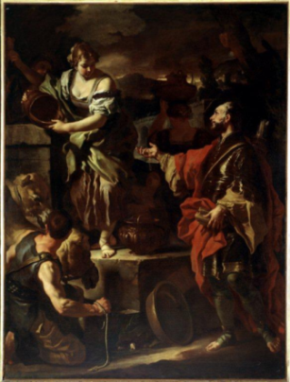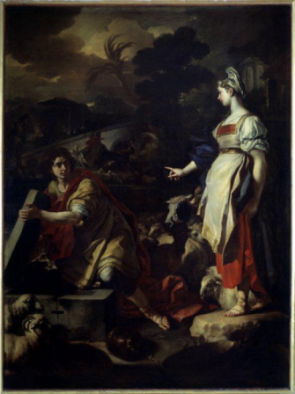Paintings by Francesco Solimena
2009 saw the conclusion of work on the restoration of two important paintings by Francesco Solimena belonging to the collection of the Accademia Galleries. Our Pro Venezia Foundation financed the restoration, which was carried out in Superintendency’s multidisciplinary laboratories sited in the historic surroundings of the former Abbazia della Misericordia. We were thus able to follow the progress of the work in detail. Before being rehung in their usual place, the paintings were exhibited in the Accademia itself in the context of a major cultural event, a fact which, albeit indirectly, was a tellingly appreciative acknowledgment of our involvement.

The subjects of both paintings refer to biblical episode recounted in the Book of Genesis (Chapters 24 and 28/9). Abraham wishes to find a wife for his son Isaac and it is important that she comes from his distant homeland. Too old to undertake the journey himself, Abraham entrusts the task to Eleazar, the oldest and most trusted of his servants. When Eleazar reaches Mesopotamia he stops at a well outside a town and waits for the women to come out to draw water; of these, the only one that offers to slake his thirst and to water the camels in his caravan is Rebecca, and he takes this as a sign that she must be the chosen one. REBECCA AND ABRAHAM’S SERVANT depicts this fateful meeting. Isaac in turn sends his son Jacob to Mesopotamia to secure one of the daughters of Laban, Rebecca’s brother, as his wife. Near the home of his ancestors, the young man comes across a well whose mouth is obstructed by a huge stone. Among the shepherds who bring their flocks to drink at the well is an extremely attractive girl who, by sheer coincidence, turns out to be one of his cousins. He hastens to reveal his identity and in the excitement of the moment manages singlehandedly to move the stone and water the family’s livestock. This is the juncture pictured in JACOB AND RACHEL.
Bernardo De Dominici gives an incomparable direct account of the life and works of Francesco Solimena (Nocera de’ Pagani 1657-Barra 1747) in his VITE DE' PITTORI, SCULTORI, ED ARCHITETTI NAPOLETANI published in 1743/44. Here we learn that “he never, from his earliest youth, gave rise to scandal, and indulged neither in gaming nor illicit love affairs"; he normally wore modest clothes in clerical style and was commonly known as “Abbé Ciccio”. He never left the immediate vicinity of Naples except for a brief visit to Rome in 1701. He nevertheless acquired considerable fame and respect and these have shown no sign of waning in the intervening years; works by him hang in the finest museums and private collections all over the world. During his long career he also made a mark as an architect and a poet and transformed his atelier into a sort of academy, from which many highly rated artists were proud to have emerged. These same artists have been criticized by some modern critics for having impeded the evolution of Neapolitan painting through their excessive determination to perpetuate the example of their great teacher long after his death.

From a stylistic point of view Solimena trained in the workshop of his father Angelo, with whom he worked for a short period at the beginning of his career. Once he struck out on his own, his idiom matured emotionally and with sparkling colour, inspired initially by the exhuberant baroque style of Luca Giordano, then the leading figure in the Neapolitan School, but he gradually tempered this and paid more attention to compositional stucture and clarity of design, with an explicit reference to classical tradition. This phase his work puts one in mind of the darkly vibrant luminism of Mattia Preti and this enables him to give greater plasticity to the figures and to fine-tune their prominence in the overall scene. At the end of his career he returned to the style of his younger days, reworking typically baroque elements though these were now out of line with new idea of stylistic expression.
The vivid contrasts of light, the compactness of forms, the volumetric balance are the paintings of Venice, among the productions of the happiest Solimena. They were designed around 1710 for the Baglioni, a family of rich industrial printing, printers, publishers and traders, especially of the liturgical books (missals, breviaries for that purpose, antiphonaries and the like), and in the palaces of which they remained until they were purchased by the Italian State in the 1920s. Already the De Dominici the specifically mentions; indeed, he reports that, in addition to those, “in the house of the Baglioni you can admire the marvellous picture of Rachel that he resigned from his old Father”. The work, now kept at the Museum Fesch, Ajaccio, it is really admirable, but for the rest of our biographer has been mistaken; in fact not the leave-taking of Rachel, it is, but that of Rebecca: first, because according to the biblical narrative, Rachel is escaped of the house with the husband, without delay, of any kind, and also because, in one of the supporting characters it is easy to recognize, Eleazar, if not for the curious clothing military which is also represented in the meeting at the well.
The photographs of the works and the description of the restoration work were kindly made available by the Soprintendenza Speciale per il Patrimonio storico, artistico ed etnoantropologico e per il Polo Museale della citta di Venezia e dei comuni della Gronda lagunare.

